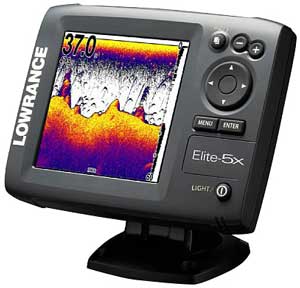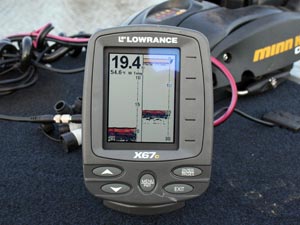
 |
| Modern fishfinders are capable of providing far more information than sonar units of yesteryear. |
The game of fishing has embraced technology full-steam, turning the art of finding and catching fish into a modern-day science. Bells and whistles have replaced the "that spot looks good" mentality, with the fish finder leading the way in terms of functionality and definite angler advantage.
These powerful tools allow a fisherman the resources to check depth, structure, fish locations, speed and temperature. Not only that, but marking productive waypoints and adding safety to your outing is a breeze with GPS technology. Follow this guide and find out what the terms mean, and what a fishfinder can ultimately do for you.
How Marine Sonar Works
Sonar works by sending out an electronic impulse from the unit to the transducer. The transducer converts the impulse into a sound wave that is beamed through the water column. The sound wave will travel downward until it reaches the bottom structure, after which it will bounce back to the transducer. The sound wave will also travel through any objects found between the lake bottom and the surface of the water (fish or baitfish). When the signal is received, the unit will then make its interpretations, finally showcasing the results on the screen. These results will include depth of bottom, any vegetation or structure found and any fish or baitfish that were located under the boat at the time of the reading.
Power (Wattage) of a Sonar Unit
The power of a sonar unit is described in Watts. The term "peak to peak" is used to describe the overall output power of the transmitter. When dealing with fishfinders, the higher the wattage, the more efficient and powerful the overall unit will be. Low wattage will ultimately bring you slow readouts, meaning a delayed reaction for a reading of a spot you have already traveled over.
The bare minimum peak-to-peak power would be 800 Watts, although 3000 plus Watts or more is certainly recommended for most anglers. One key point to remember: the shallower the water you fish, the less power you will need. For those that fish deep water (such as the Great Lakes or saltwater) it is best to choose the most powerful unit that your wallet will allow.
Fish Finder Screen's Pixels
The number of pixels that a fish finder screen is made up of is a very important step in deciphering the quality and performance of the unit. Simply put, a pixel is a dot. The display screen is made up of a series of many dots, which in turn produce the "picture" or read out. The more pixels present on a screen, the better the picture will appear. (As the pixel count goes down, the more "blocky" or less distinguishable the screen read out will appear.)
 |
| Color display makes fish and structure literally pop out in different hues on color displays, which makes for easier interpretation, identification and separation from the surrounding enviroment. |
240V x 160H pixels is the bare minimum when it comes to choosing a fish finder. Anything less, and it will resemble an outdated video game. Again, the more money you are willing to spend, the better the product you can purchase. 240 x 240 pixels would be a great starting point (and a minimum in my books), but certainly move higher if you are able to. The bigger the numbers = improved viewing. You won't regret it in the long run.
The Fish Finder Transducer
The transducer is the part that sends out sound waves in order to see what is below the surface of the water. When dealing with transducers, the most important aspect is cone angle. In layman's terms, the cone refers to how wide of a beam is sent out from the bottom of your boat. (It starts out narrow at the transducer and widens as it gets deeper.) The wider the degree on the cone, the larger the view of what lies beneath. As you move deeper, the coverage will widen and vice versa. Keep in mind that as cone angles widen, sensitivity begins to diminish in very deep water.
Transducer cones can be purchased in ranges from 9-degrees upwards of 60-degrees, with most units falling somewhere between 16 and 20-degrees. A cone of 20-degrees is a perfect starting point for anglers fishing a variety of water depths. Many dual frequency transducers will come with both 20 and 60 degree cones.
Frequencies also come into play with transducers. Most will come with either 50, 83, 192 or 200 kHz frequencies, all in direct relation to the cone angle. The higher frequencies (192 and 200 kHz) work best in shallow water, while the low 50 kHz transducers work best for deep water applications.
Another interesting aspect of transducers is the ability to have more than one cone transmitting from the same starting point. In other words, the standard transducer will have a single beam. Moving up the scale, you can then progress to a dual beam, triple beam, side beam and so forth. What each of these does is cover more water — a very efficient option to have when scouring the lake for fish. Some models will come standard with these accessories, while others will require an upgrade. Again, cost will come into effect for these pricier, but significant advantages. Dual beams are far superior to single beams if your main playing area is relatively shallow water, as they will cover more of the water effectively.
Side Scan Technology
 |
| A transducer is responsible for sending and receiving the sound waves that are used to create onscreen data. |
Side scan technology is a revolutionary design that can allow an angler to see what is to the side of the boat, all from a bird's eye view on the screen. These amazingly clear, picture-like images will showcase every nook and cranny to the left and right of your craft (240 feet each!), saving you hours of spent time in comparison to working over the same area with a regular downward transducer beam.
This function will cut through murky water with ease, showing you rock piles, humps, and schooling fish you would never have known were there. For tournament anglers or serious fishermen, a side scan is a definite luxury that can up the catch quota, and learning curve, considerably.
Fish Finder Display Screens
Color displays can be found everywhere on the electronics market, and for good reason. Color will allow you a greater screen definition, making fish and structure literally "pop out" in different hues, which makes for easier interpretation and identification. I find color screens easier to see in bright light, and viewing them under dark or cloudy conditions makes them stand out positively brilliant.
New to the market are HD (high definition) screens. These realistic units give the same quality and "pow" that your HDTV does for your home, giving you the best quality and highest realism possible. The maps look beyond life like! Yes, HD does come with a higher price tag, but, like high-speed internet and dial-up internet, there's just no comparison between regular color and HD.
Black-and-white displays still have a place in the fishfinder market, but for the difference in price, I definitely suggest going at least the route of color. Saying that, black and white is better than nothing, so if that's all your funds will allow at this time, then make the purchase.
Screen size is another aspect of your fishfinder that should be given some thought. Generally, the lower-end units are always smaller in stature. This works well if it is to be used as a secondary unit or backup, but for your main electronics, always go with the largest size you can afford. A bigger screen equates to a greater viewing surface, meaning structure, digital readouts (depths, temperature, etc,) and chart plotting will be easier to see and recognize. The quality will be much better, also. A five-inch screen is a great starting point to consider.
Choosing Options: Temperature, Speed and Distance
Although standard on many units on the market, some lower-end fishfinders will offer these add-ons as options. All have a place and time, and most are a personal choice in relation to your particular style of fishing. For those that primarily troll, the speed and distance feature will certainly improve your creel count. (You can tell the exact speed you were traveling when a fish strikes -- important stuff for those looking to duplicate their catch.) The same goes for drift fishing, especially when your targeted species is picky about how fast they will chase down a bait.
Having a temperature gauge on board is extremely important in my books, for the sole fact of finding warmer water or helping you locate the preferred range for fish. This feature works wonders for me during early season crappie forays, especially when fish are up spawning in shallow water. It goes without saying that my temperature gauge helps me locate and key in on these fussy fish. Both options are mandatory in my eyes.
Choose a Portable or Fixed Fish Finder
 |
| Many anglers prefer to mount their primary display in the console area and a secondary unit at the bow of their boat. |
Anglers have the option of purchasing a fish finder that will be affixed permanently to their craft, or one that can be taken in and out of the boat with ease.
For those that rent boats, ice fish or go on fly-in retreats, the portable option is one to look into. It can be used in a variety of situations, and the compact size and carrying case make travel a breeze. They will also perform as proficiently as the fixed models, with the only difference being their portability.
Fixed fishfinders certainly get the nod for boat owners, as they can be mounted in the exact position they desire, with wires "hidden" underneath floor boards and bow. The transducer can also be attached to either the stern, trolling motor, or hull in order for it to be out of the way and securely held. (Portable units often use a suction cup for attachment purposes.)
The GPS Option
GPS, or Global Positioning Systems, use satellites in the sky to pinpoint your exact location when out on the water. This feature allows you to mark productive spots (and come back to them time and time again), find your way back to shore in the case of an emergency and also map out co-ordinates for your home lake through the use of mapping software.
Most GPS fishfinders are combo units, meaning they have both a depth sounder as well as a chartplotter. A chartplotter will showcase your location, superimposed over a map. This allows you to know your exact location at all times. Entering waypoints is as easy as pushing a button with these units, and this priceless function will allow you to mark fish, structure, launch ramps, or anything else you desire. Once saved, that information can be selected at any time, and those spots can be revisited, or avoided, during future visits. (This is an awesome feature for returning to that honey hole of a mid-lake hump!)
For those that do big-water fishing or certainly tournament anglers, having GPS built into your fish finder will open up a new world of fishing fun and increased catch rates.
As you can see, fishfinders are an important addition to your fishing arsenal. I can guarantee that they will increase your catch rates, and in the world of angling, that's what each and every one of us strives for when out on the water.
- 29883 views

